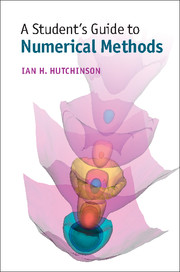Book contents
- Frontmatter
- Dedication
- Contents
- Preface
- 1 Fitting functions to data
- 2 Ordinary differential equations
- 3 Two-point boundary conditions
- 4 Partial differential equations
- 5 Diffusion. Parabolic partial differential equations
- 6 Elliptic problems and iterative matrix solution
- 7 Fluid dynamics and hyperbolic equations
- 8 Boltzmann's equation and its solution
- 9 Energy-resolved diffusive transport
- 10 Atomistic and particle-in-cell simulation
- 11 Monte Carlo techniques
- 12 Monte Carlo radiation transport
- 13 Next steps
- Appendix A Summary of matrix algebra
- References
- Index
12 - Monte Carlo radiation transport
Published online by Cambridge University Press: 05 May 2015
- Frontmatter
- Dedication
- Contents
- Preface
- 1 Fitting functions to data
- 2 Ordinary differential equations
- 3 Two-point boundary conditions
- 4 Partial differential equations
- 5 Diffusion. Parabolic partial differential equations
- 6 Elliptic problems and iterative matrix solution
- 7 Fluid dynamics and hyperbolic equations
- 8 Boltzmann's equation and its solution
- 9 Energy-resolved diffusive transport
- 10 Atomistic and particle-in-cell simulation
- 11 Monte Carlo techniques
- 12 Monte Carlo radiation transport
- 13 Next steps
- Appendix A Summary of matrix algebra
- References
- Index
Summary
Transport and collisions
Consider the passage of uncharged particles through matter. The particles might be neutrons, or photons such as gamma rays. The matter might be solid, liquid, or gas, and contain multiple species with which the particles can interact in different ways. We might be interested in the penetration of the particles into the matter from the source, for example what is the particle flux at a certain place, and we might want to know the extent to which certain types of interaction with the matter have taken place, for example radiation damage or ionization. This sort of problem lends itself to modelling by Monte Carlo methods.
Since the particles are uncharged, they travel in straight lines at constant speed between collisions with the matter. Actually, the technique can be generalized to treat particles that experience significant forces so that their tracks are curved. However, charged particles generally experience many collisions that perturb their velocity only very slightly. Those small-angle collisions are not so easily or efficiently treated by Monte Carlo techniques, so we simplify the treatment by ignoring particle acceleration between collisions.
A particle executes a random walk through the matter, illustrated in Fig. 12.1. It travels a certain distance in a straight line, then collides. After the collision it has a different direction and speed. It takes another step in the new direction, generally with a different distance, to the next collision. Eventually, the particle has an absorbing collision, or leaves the system, or becomes so degraded (for example in energy) that it need no longer be tracked. The walk ends.
12.1.1 Random-walk step length
The length of any of the steps between collisions is random. For any collision process, the average number of collisions a particle has per unit length corresponding to that process, which we'll label j, is njσj, where σj is the cross-section, and nj is the density in the matter of the target species that has collisions of type j.
- Type
- Chapter
- Information
- A Student's Guide to Numerical Methods , pp. 158 - 170Publisher: Cambridge University PressPrint publication year: 2015



